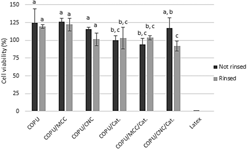Crossref Citations
This article has been cited by the following publications. This list is generated based on data provided by
Crossref.
Wu, Mingyue
Hu, XiangMing
Hu, ZunXiang
Zhao, Yanyun
Cheng, WeiMin
and
Lu, Wei
2019.
Two-component polyurethane healing system: Effect of different accelerators and capsules on the healing efficiency of dynamic concrete cracks.
Construction and Building Materials,
Vol. 227,
Issue. ,
p.
116700.
Wu, Guomin
Bian, Junna
Liu, Guifeng
Chen, Jian
Huo, Shuping
Jin, Can
and
Kong, Zhenwu
2020.
Self-Catalytic Two-Component Waterborne Polyurethanes with Amino Polyols from Biomass Based Epoxy Resin.
Journal of Polymers and the Environment,
Vol. 28,
Issue. 2,
p.
713.
Gao, Yang
Dong, Haijun
Liu, Licheng
Yu, Yingfeng
Tang, Zhengming
Bai, Chenyan
Schmidt, Thorsten
Feng, Yanli
and
Chen, Hongyu
2020.
Tin-Containing Crystalline Copolymers as Latent Catalysts for Polyurethanes.
ACS Applied Polymer Materials,
Vol. 2,
Issue. 11,
p.
4531.
Chakraborty, Indranil
and
Chatterjee, Kaushik
2020.
Polymers and Composites Derived from Castor Oil as Sustainable Materials and Degradable Biomaterials: Current Status and Emerging Trends.
Biomacromolecules,
Vol. 21,
Issue. 12,
p.
4639.
Saha, Pathikrit
Khomlaem, Chanin
Aloui, Hajer
and
Kim, Beom Soo
2021.
Biodegradable Polyurethanes Based on Castor Oil and Poly (3-hydroxybutyrate).
Polymers,
Vol. 13,
Issue. 9,
p.
1387.
Maia, Lana S.
Zanini, Noelle C.
Claro, Amanda Maria
do Amaral, Nayara Cavichiolli
Barud, Hernane S.
and
Mulinari, Daniella R.
2021.
Eco‐friendly foams of castor oil based‐polyurethane with Artemisia residue fillers for discarded vegetable oil sorption.
Journal of Applied Polymer Science,
Vol. 138,
Issue. 43,
Li, Aodian
Wang, Tiantian
Feng, Yunyun
Qin, Qiqi
Jiang, Wujiu
and
Tan, Yuxing
2022.
Synthesis, Crystal Structure, and Anticancer Activity of the Dinuclear Dibutyltin Complexes.
Russian Journal of General Chemistry,
Vol. 92,
Issue. 5,
p.
908.
Porto, Deyvid S.
Cassales, Ana
Ciol, Heloisa
Inada, Natalia M.
and
Frollini, Elisabete
2022.
Cellulose as a polyol in the synthesis of bio-based polyurethanes with simultaneous film formation.
Cellulose,
Vol. 29,
Issue. 11,
p.
6301.
Liu, Licheng
Dong, Haijun
Yu, Yingfeng
Tang, Zhengming
Bai, Chenyan
Feng, Yanli
Chen, Hongyu
and
Schmidt, Thorsten
2023.
Polyurethane latent catalysts obtained by emulsion solvent evaporation.
Polymer Bulletin,
Vol. 80,
Issue. 3,
p.
3377.
Morales-González, Maria
Navas-Gómez, Kelly
Diaz, Luis E.
Gómez-Tejedor, José A.
and
Valero, Manuel F.
2023.
Incorporation of Chitosan in Polyurethanes Based on Modified Castor Oil for Cardiovascular Applications.
Polymers,
Vol. 15,
Issue. 18,
p.
3733.
Lam, Ki Yan
Lee, Choy Sin
Pichika, Mallikarjuna Rao
Cheng, Sit Foon
and
Tan, Rachel Yie Hang
2024.
Non‐isocyanate polyurethane‐acrylate as UV‐ and thermo‐responsive plasticizer for thermoplastic elastomer.
Journal of Applied Polymer Science,
Vol. 141,
Issue. 30,
Lima, Amanda Schueng
and
Magnago, Rachel Farvezani
2024.
Polyurethanes Thermal, Hydrolytic and Soil Degradation: Systematic Literature Review.
Ciência e Natura,
Vol. 46,
Issue. ,
p.
e73521.
Yan, Jinyuan
Li, Rui
Jiang, Ruihong
Yu, Jie
Tang, Qing
and
Song, Dayu
2024.
Molecular design and hygrothermal resistance of high‐toughness polysiloxane–polyurethane block copolymer composite adhesives.
Journal of Applied Polymer Science,
Vol. 141,
Issue. 18,
Altarugio, Julia P.
Staffa, Lucas H.
Carvalho, Antonio J. F.
and
Almeida, Juliana M. P.
2024.
Influence of PMMA particle size control on the transmittance of PMMA/tempo-oxidized cellulose composites.
Journal of Materials Research,
Vol. 39,
Issue. 1,
p.
107.
